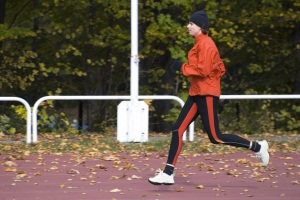 No need to be stuck in the gym all winter long! Exercising out in the fresh winter air can be healthy and invigorating. The American Council on Exercise encourages people to get outside to exercise even when the weather is cold, as long as they take proper precautions to avoid hypothermia. Those who have asthma or heart problems may wish to check with their doctor before beginning a cold-weather exercise program if they feel it could be an issue.
No need to be stuck in the gym all winter long! Exercising out in the fresh winter air can be healthy and invigorating. The American Council on Exercise encourages people to get outside to exercise even when the weather is cold, as long as they take proper precautions to avoid hypothermia. Those who have asthma or heart problems may wish to check with their doctor before beginning a cold-weather exercise program if they feel it could be an issue.
Check the temperature AND the wind chill – The US National Safety Council advises that exercising in temperatures 20°F and above is generally safe. However, there is an increased risk of hypothermia in temperatures below that, particularly if there is a wind chill involved. Be sure to check the weather conditions before setting out.
Dress in layers – Obviously, you want to dress warmly so as to avoid hypothermia, but you also do not want to become overheated and sweat excessively. Dressing in layers allows you to remove a layer as you become warmer, and also is better at keeping out the wind and cold. The layer closest to your skin should be a light layer of synthetic material that will wick away moisture from your skin and that will dry quickly. The next layer should be of polyester fleece or wool to keep you warm, and the top layer should be a lightweight waterproof shell.
Cover your head and neck – Half of your body’s heat is lost through your head, so be sure to cover it with a warm hat. Even better is something like a balaclava that will keep your head, neck, ears and much of your face warm as you exercise.
Wear mittens – Although insulated gloves can keep your hands warm, mittens are sometimes a better option, as your fingers being enclosed in the same space help to keep each other warm. You can also insert disposable hand warmers into your mittens before you set out and you’ll be good to go for hours.
Wear appropriate footgear – In snow and ice, injuries from falls are far more common and can put your exercise routine on hold for weeks. In slippery conditions, be sure you have footgear that has a good grip. Nonslip devices such as Yaktrax attach to your workout shoes to give you more traction on packed snow and ice.
Keep hydrated – Even in chilly conditions it is important to remember to drink water as you exercise. You still sweat and lose water through evaporation and through your breath, so be sure to take regular water breaks during your workout. Keep your water bottle in an inside pocket of your clothing to keep it from freezing.
By keeping these cold weather exercise tips in mind, you can enjoy the winter weather and stay fit year-round!

